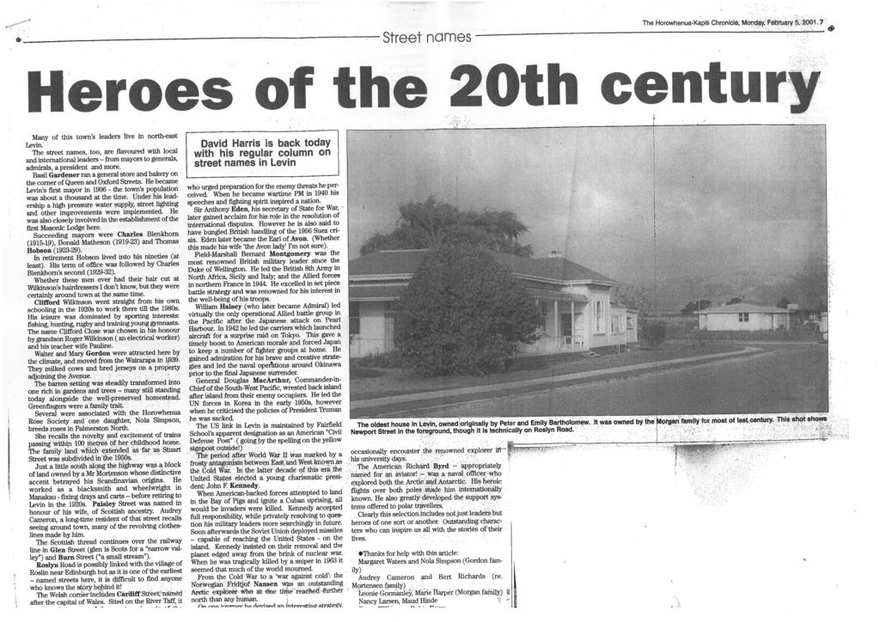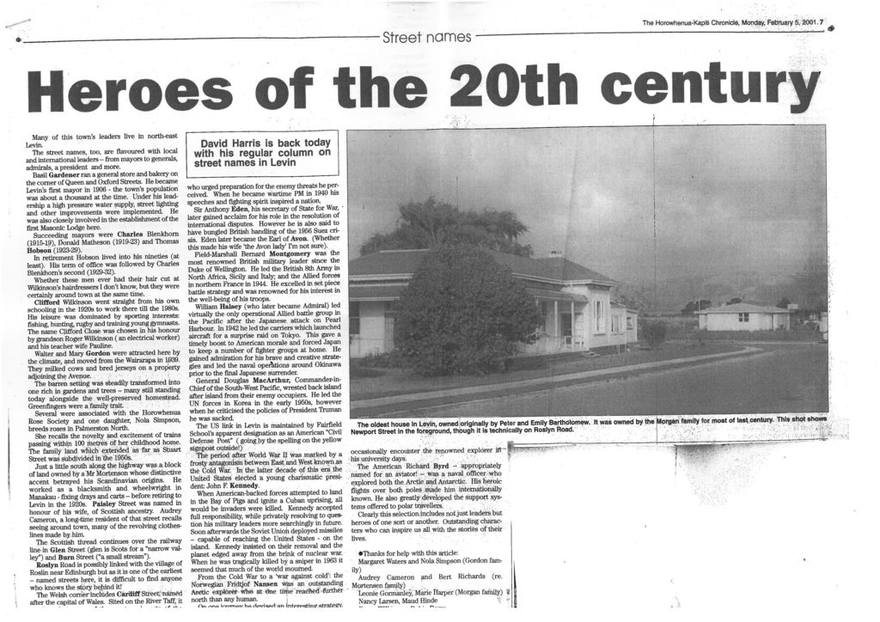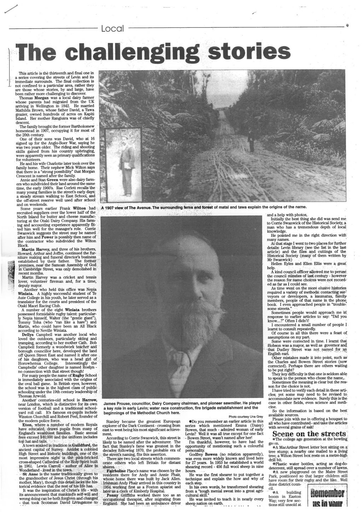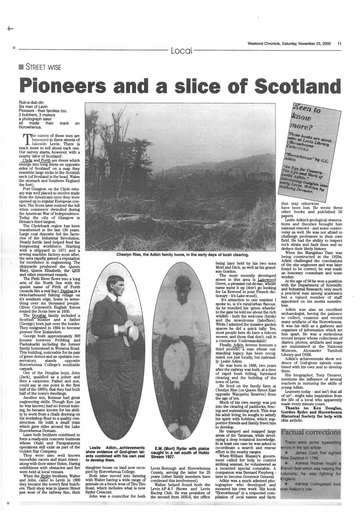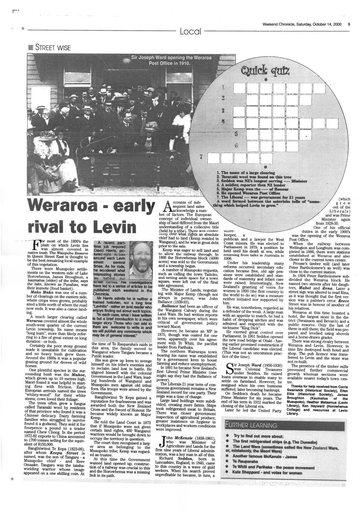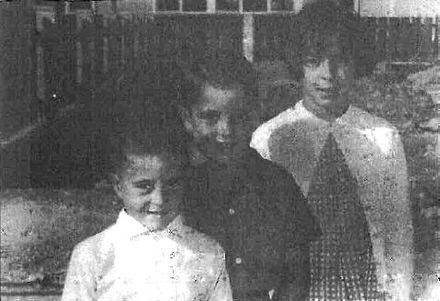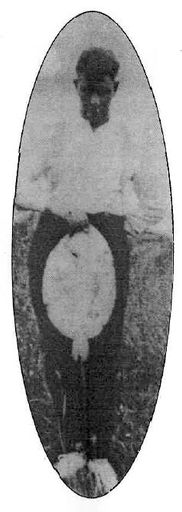Heros of the 20th century
- Description
Heroes of the 20th century
Many of this town's leaders live in north-east Levin.
The street names, too, are flavoured with local and international leaders — from mayors to generals, admirals, a president and more.
Basil Gardener ran a general store and bakery on the corner of Queen and Oxford Streets. Ile became Levin's first mayor in 1906 - the town's population was about a thousand at the time. Under his leadership a high pressure water supply, street lighting and other improvements were implemented. He was also closely involved in the establishment of the first Masonic Lodge here.
,Succeeding mayors were Charles Blenkhorn (191549), Donald Matheson (1919-23) and Thomas Hobson (1923-29).
In retirement Hobson lived into his nineties (at least). His term of office was followed by Charles Blenkhorn's second (1929-32).
Whether these men ever had their hair cut at Wilkinson's hairdressers I don't know, but they were certainly around town at the same time.
Clifford Wilkinson went straight from his own schooling in the 1920s to work there till the 1980s. His• leisure was dominated by sporting interests: fishing, hunting, rugby and training young gymnasts. The name Clifford Close was chosen in his honour by,grandson, Roger Wilkinson ( an electrical worker) and his teacher wife Pauline.
Walter and Mary Gordon were attracted here by the climate, and moved from the Wairarapa in l939. They milked cows and bred jerseys on a property adjoining the Avenue.
The barren setting was steadily transformed into one rich in gardens and trees — many still standing today alongside the well-preserved homestead. Greenfingers were a family trait.
Several were associated with the Horowhenua Rose Society and one daughter, Nola Simpson, breeds roses in Palmerston North.
She recalls the novelty and excitement of trains passing Within 100 metres of her childhood home.
The family land which extended as far as Stuart Street was subdivided in the '1950s.
Just a little south along the highway was a block of land owned by a Mr Mortenson whose distinctive accent betrayed his Scandinavian origins. He worked as a blacksmith and wheelwright in Manakau - fixing drays and carts — before retiring to Levin in the 1920s. Paisley Street was named in honour of his wife, of Scottish ancestry. Audrey Cameron, a long-time resident of that street recalls seeing around town, many of the revolving -clotheslines made by him.
The Scottish thread continues_ over the railway line - in Glen Street (glen is Scots for a "narrow valley") and Burn Street ("a small stream").
Roslyn Road is possibly linked with the village of Roslin near Edinburgh but as it is one of the earliest -named streets here, it
The Welsh corner includes Cardiff Street, named after the capital of Wales. Sited on the River Taff,' it has long been one of the great coal ports of the world.
The town of Conway is known for its castle - a massive fortress atop a rocky promontory with sater on three sides - virtually impregnable. At the oppostie extremewas the 'castle of lost Causes' in Harlech. This Cardigan Bay town is also a popular beach resort. The town, of Newport on the heavily-industrustrialised south coast evokes memories -- for New Zealanders and Welshmen — of a famous rugby victory by the local club in 1963. 3-0 over an All. Black team which - included Whineray, Lochore, .,Tremain and the Meads brothers.
 The Welsh connection is likely linked to. the Morgan family's former ownership of this block of ten acres. They also owned the original homestead of sawmiller Peter Bartholomew from 1907 till very recently (See photo at left). Hereford is an English county just over the Welsh border which has suffered in the crossfire of battle over the centuries. It is also the name of a breed of cattle sought around the world and known for its hardiness in extremes of climate, rapid growth and early maturity. It is tempting to surmise that Highfield Street and Fairfield Road are named for the original landscape.
The Welsh connection is likely linked to. the Morgan family's former ownership of this block of ten acres. They also owned the original homestead of sawmiller Peter Bartholomew from 1907 till very recently (See photo at left). Hereford is an English county just over the Welsh border which has suffered in the crossfire of battle over the centuries. It is also the name of a breed of cattle sought around the world and known for its hardiness in extremes of climate, rapid growth and early maturity. It is tempting to surmise that Highfield Street and Fairfield Road are named for the original landscape.The next cluster of names are synonymous with the Second World War.
FranklinD. Roosevelt was elected American president during the Great Depression and became renowned for his 'fireside 'chats' - regular radio messages to the People. Despite being Stricken by polio and confined to a Wheelchair he became the only four-term leader in US history.
Sir Winston Churchill's earlier jobs included being a war correspondent during the Anglo-Boer War and an unsuccessful novelist. He later authored highly regarded histories of both world wars and a biography of his ancestor, the Duke of Marlborough — the general who led the English to several great victories in the early 1700s. -Churchill was a member of parliament for half a century, at times being a 'voice in the wilderness' who urged preparation for the enemy threats he perceived. When he became Wartime PM in 1940 his speeches and fighting spirit inspired a nation.
Sir Anthony Eden, his secretary of State for War, later gained acclaim for his role in the resolution Of international disputes. However he is also said to have bungled British handling of the 1956 Suez crisis. Eden later became the Earl of Avon. (Whether this made his wife the Avon lady I'm not sure).
Field-Marshall Bernard Montgomery was the most renowned British military leader since the Duke of Wellington. He led the British 8th Army in North Africa, Sicily and Italy; and the Allied forces in northern France in 1944. He excelled in set piece battle strategy and was renowned for his interest in the well-being of his troops.
William Halsey (who later became Admiral) led virtually the only operational Allied battle group in the Pacific after the Japanese attack on Pearl Harbour. In 1942 he led the carriers' which launched aircraft for a surprise raid on Tokyo. This gave a timely boost to American morale and forced Japan to keep a number of fighter groups at home. He gained admiration for his brave and creative strategies and led the naval operations around Okinawa prior to the final Japanese Surrender.
 General Douglas MacArthur, Commander-in-Chief of the South-West Pacific, wrested back island after island from their enemy occupiers. He led the UN forces in Korea in the early 1950s, however when he criticised the policies of President Truman he was sacked.
General Douglas MacArthur, Commander-in-Chief of the South-West Pacific, wrested back island after island from their enemy occupiers. He led the UN forces in Korea in the early 1950s, however when he criticised the policies of President Truman he was sacked. Photo: Looks east along Macarthur Street from the rise near Cambridge Street. Queenwood Road can be seen on the right. (Circa 1912). -
The US link in Levin is Maintained by Fairfield School's apparent designation as an American "Civil Defense Post" (going by the spelling on the yellow signpost outside!)
The period after World War II Was .marked by a frosty antagonisb between East and West known the •Cold War. 'In the.latter decade of this era the United States elected a young charismatic President: John E Kennedy.
When American-backed forces attempted to land in the Bay of Pigs and ignite a Cuban uprising, all would be invaders were killed. Kennedy accepted full responsibility, while privately resolving to question his military leaders more searchingly in future. Soon afterwards the Soviet Union deployed missiles — capable of reaching the United States - on the island. Kennedy insisted on their removal and the planet edged away from the brink of nuclear war. When he was tragically killed by a sniper in 1963 it seemed that much of the world mourned.
From the Cold War to a `war against cold': the Norwegian Fridtjof Nansen was an outstanding Arctic explorer - who at one reached furrther north than any human.
On one journey he devised an interesting strategy. By travelling up the east coast of Greenland – uninhabited and less frequented – he deliberately cut off his own retreat and so forced himself onward. Noting the westward drift of the,polar ice he initiated another novel approach: building a base ship which would be lifted, rather than crushed, by the ice. This vessel, the Fram (which means 'forward') is preserved in the ,Norwegian capital Oslo.
Nansen was a hero to many Norwegians, of course. One countryman who admired him greatly was the farmer Arne Larsen who owned the four and a half acre block encompassing these two sireets. According to his wife Nancy, Arne would occasionally encounter the renowned explorer in his university days.
The American Richard Byrd - appropriately named for an aviator! - was a naval officer who explored both the Arctic and Antarctic. His heroic flights over both poles made him internationally known. He also greatly developed support systems offered to polar travellers.
Clearly this section also includes not just leaders but heroes of one sort or another. Outstanding characters who can inspire us all with the stories of their lives.
Thanks for help with this article:- Margaret Waters and Nola Simpson (Gordon family)
- Audrey Cameron and Bert Richards (re. Mortensen family).
- Leonie Gormanley, Marie Harper (Morgan family), Nancy Larsen, Maud Hinde
- Roger Wilkinson, Robin Barry
- Jack Blenkhorn
- Horowhenua Historical Society (for photos)
- Levin Library
INVITATION (as published in original publication - In Kete please feel free to add any information you have yourself- online)A large number of readers have helped with information in recent weeks. We welcome feedback on these articles corrections, additions or otherwise. If anyone has information regarding Green Avenue please contact the writer through the Chronicle.
Flashbacks:
- Sorry Prince Charles — there are no Levin streets named particularly for you, despite two attempts (one of them mine!)
- Walter Gordon originally wanted to name what is now Stuart Street after Charles. He had an affinity for the young royal whose birthday was one day before his. However the council disallowed it and instead he chose to acknowledge his Scottish roots (Stuart and Dee Streets).
- Jack Blenkhorn, born here in 1907,. explained to me that Charles Street honours his father Charles Blenkhorn, our second mayor. The name was chosen by the Kilsbys when they subdivided the land around the 1960s.
- Charles Blenkhorn at one stage. owned a mine during the Coromandel gold rush and was decorated for bravery in the Anglo-Boer War. Arriving in Levin in 1907 he was only the second lawyer in town. His son Jack recalls that during the influenza epidemic in the early part of last century, he was one of a number of locals who took stiffering Maori - who were loathe to seek treatment - to the makeshift 'hospital'.
Identification
- Date
- February 5, 2001
Taxonomy
- Community Tags

